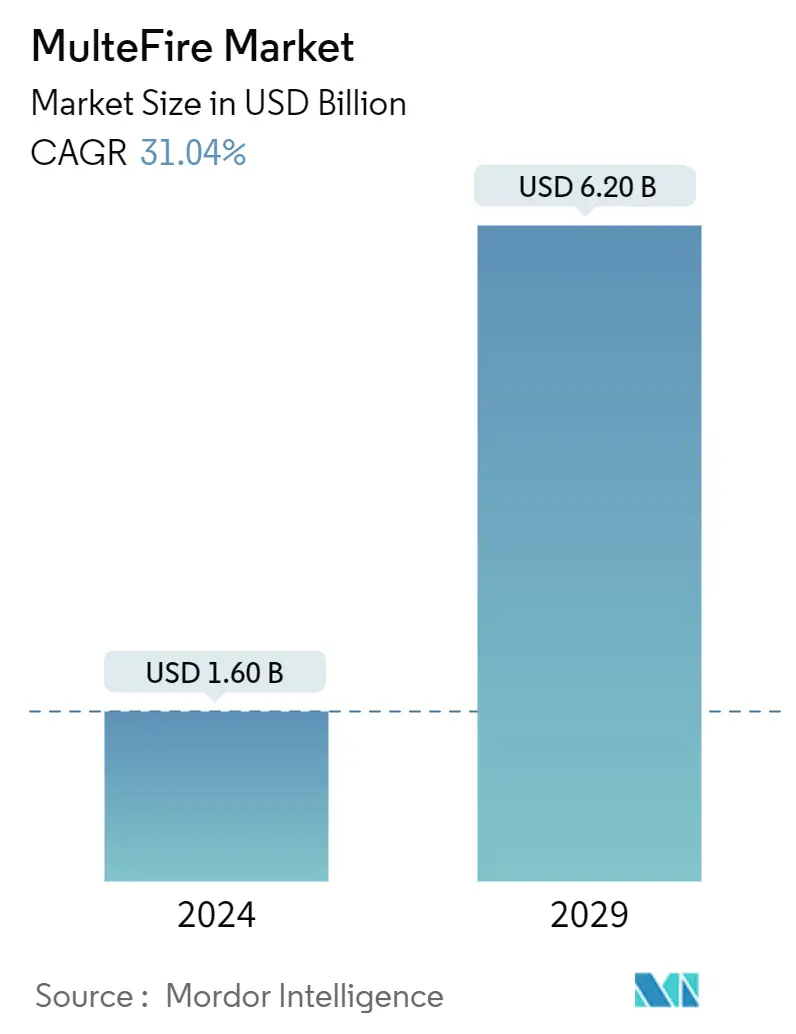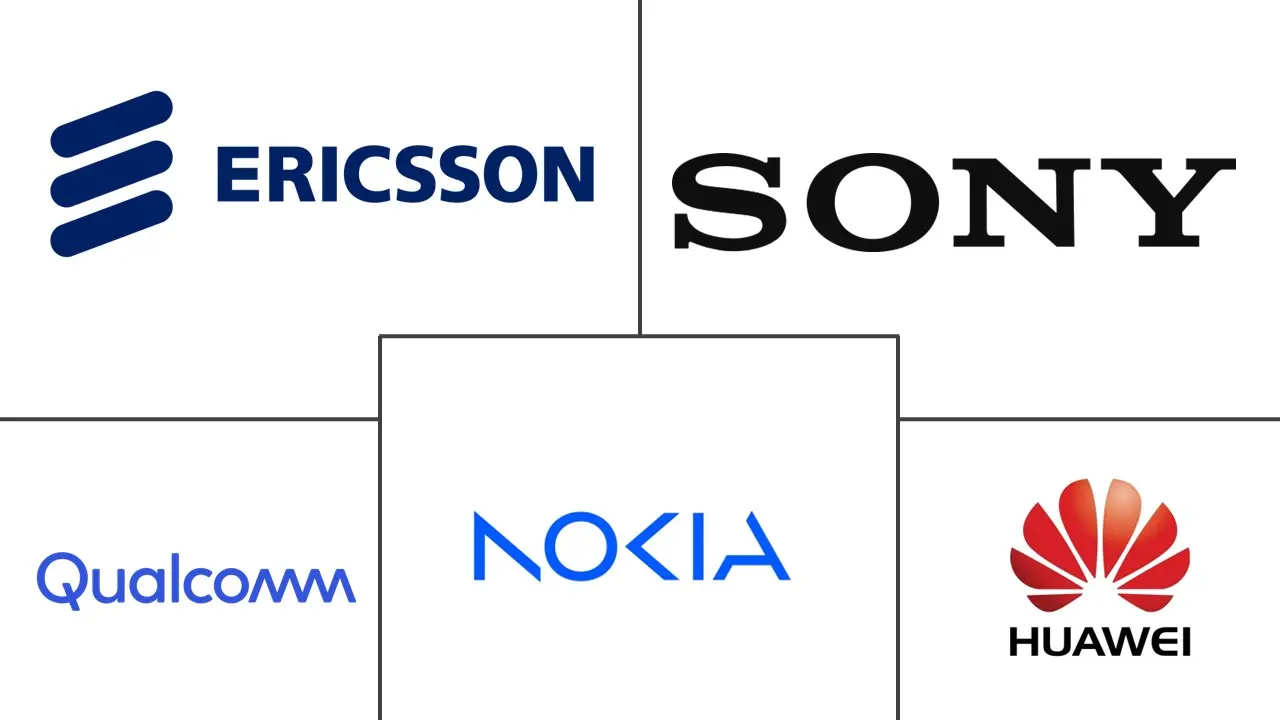Market Size of MulteFire Industry

| Study Period | 2019 - 2029 |
| Market Size (2024) | USD 1.60 Billion |
| Market Size (2029) | USD 6.20 Billion |
| CAGR (2024 - 2029) | 31.04 % |
| Fastest Growing Market | Asia Pacific |
| Largest Market | North America |
| Market Concentration | Low |
Major Players
*Disclaimer: Major Players sorted in no particular order |
MulteFire Market Analysis
The MulteFire Market size is estimated at USD 1.60 billion in 2024, and is expected to reach USD 6.20 billion by 2029, growing at a CAGR of 31.04% during the forecast period (2024-2029).
The network's capacity has become limited as a result of the rising reliance on wireless connections to provide rich information to an ever-growing number of devices. Therefore, this encouraged the creation of MulteFire, which was intended to be a vital component of the solution to the growing mobile data traffic issue.
- MulteFire will be a critical enabler allowing enterprises to deploy LTE private networks without the involvement of a mobile network operator in unlicensed regional and global spectrum bands around the world, which includes the 2.4 GHz and 5 GHz global bands and the 800/900 MHz and 1.9 MHz regional bands.
- MulteFire, with its standalone feature, will open up an unlicensed spectrum to a host of new players, including wireless ISPs, global enterprises, specialist verticals, and even network operators, where all can deploy MulteFire-based LTE private networks.
- MulteFire enables the deployment of enhanced broadband services in more places with the combination of the enhanced performance of LTE with the deployment simplicity of the unlicensed spectrum. Since MulteFire is based on LTE, it will operate in wider bandwidths that support up to 20 MHz to support high capacity and low latency, capable of peak data rates up to 400 Mbps.
- The use of unlicensed spectrum by businesses or cable providers to create their own LTE networks may be made possible by MulteFire. When paired with LTE features like increased security, major organizations that lack licensed spectrum and desire greater mobility than Wi-Fi generally offers are expected to embrace MulteFire in industrial sectors like shipping ports, mines, and airports, among others. Additionally, MulteFire is predicted to be a connection choice for IoT deployments.
- The rise in the need for more scalable and advanced network connectivity for industrial IoT (IIoT) applications is one of the key factors anticipated to propel multefire market expansion over the projected period. Additionally, the increased need for high-performance and simple-to-deploy wireless connection networks is expected to fuel the multefire market's expansion.
- However, the increased need for high-capacity, cost-effective networks is predicted to limit the multefire market's expansion. On the other side, the growth of the multefire market in the timeframe period is further anticipated to be hampered by the delay in decisions relating to the utilization of shared spectrum.
- The COVID-19 has had a significant impact on the Multefire market. The rapid closure of various manufacturing firms and businesses significantly impacted the market. During the mid-first phase, the COVID-19 outbreak has caused changes in internet usage and download speeds monitored on servers based on internet quality to be seen in various places, increasing traffic volume. The most significant increases in traffic volume were observed practically everywhere immediately following announcements of official policies, such as school closings and instructions to stay at home.
MulteFire Industry Segmentation
MulteFire can be defined as an LTE-based system that runs independently in unlicensed and shared airwaves, including the global 5 GHz bands. MulteFire offers seamless mobility to support service continuity between small cells and other networks. Enterprises using MulteFire will be able to help critical voice and data applications such as high-speed mobile broadband for messaging, videos, and images. MulteFire technology is deployed in commercial and institutional buildings, supply chain and distribution, retail, hospitality, public venues, and healthcare sectors.
The multefire market is segmented by equipment type (small cells, switches, and controllers), end-user vertical (commercial and institutional buildings, supply chain and distribution, retail, hospitality, public venues, and healthcare), and geography (North America[United States, Canada], Europe [Germany, United Kingdom, France, Rest of Europe], Asia-pacific [India, China, Japan, Rest of Asia-Pacific], Latin America[Brazil, Argentina, Rest of Latin America], and Middle East and Africa[United Arab Emirates, Saudi Arabia, Rest of Middle East and Africa])..The market sizes and forecasts are provided in terms of value (USD) for all the above segments.
| Equipment Type | |
| Small Cells | |
| Switches | |
| Controllers |
| End User Vertical | |
| Commercial & Institutional Buildings | |
| Supply Chain and Distribution | |
| Retail | |
| Hospitality | |
| Public Venues | |
| Healthcare | |
| Others |
| Geography | ||||||
| ||||||
| ||||||
| ||||||
| ||||||
|
MulteFire Market Size Summary
The MulteFire market is poised for significant growth, driven by the increasing demand for scalable and advanced network connectivity, particularly in industrial IoT applications. MulteFire technology enables enterprises to deploy LTE private networks without relying on mobile network operators, utilizing unlicensed spectrum bands globally. This capability is particularly beneficial for sectors such as shipping ports, mines, and airports, where enhanced mobility and security are crucial. The technology's ability to operate in wider bandwidths supports high capacity and low latency, making it an attractive option for organizations seeking greater mobility than traditional Wi-Fi offers. The MulteFire Alliance's collaboration with the Alliance of Industrial Internet to promote private LTE networks further underscores the technology's potential in enterprise and industrial IoT use cases.
North America is expected to be a key region for MulteFire deployment, supported by the presence of major companies like Qualcomm, Intel, and Verizon, which are members of the MulteFire Alliance. The region's initiatives to standardize 5G NR in unlicensed spectrum and the rapid rollout of 5G networks are likely to drive market growth. The increasing adoption of IoT devices and Industry 4.0 solutions in North America necessitates reliable and secure networks for data transfer, further boosting MulteFire's market potential. The market is relatively consolidated, with prominent players engaging in innovations and partnerships to enhance their market share. Recent developments, such as Nokia's extended partnership with Kyndryl and Deutsche Telekom's plans to deploy small cells, highlight the ongoing efforts to leverage unlicensed wireless networking solutions like MulteFire.
MulteFire Market Size - Table of Contents
-
1. MARKET INSIGHTS
-
1.1 Market Overview
-
1.2 Industry Value Chain Analysis
-
1.3 Industry Attractiveness - Porter's Five Forces Analysis
-
1.3.1 Bargaining Power of Suppliers
-
1.3.2 Bargaining Power of Buyers/Consumers
-
1.3.3 Threat of New Entrants
-
1.3.4 Threat of Substitute Products
-
1.3.5 Intensity of Competitive Rivalry
-
-
1.4 Assessment of the Impact of COVID-19 on the Market
-
-
2. MARKET SEGMENTATION
-
2.1 Equipment Type
-
2.1.1 Small Cells
-
2.1.2 Switches
-
2.1.3 Controllers
-
-
2.2 End User Vertical
-
2.2.1 Commercial & Institutional Buildings
-
2.2.2 Supply Chain and Distribution
-
2.2.3 Retail
-
2.2.4 Hospitality
-
2.2.5 Public Venues
-
2.2.6 Healthcare
-
2.2.7 Others
-
-
2.3 Geography
-
2.3.1 North America
-
2.3.1.1 United States
-
2.3.1.2 Canada
-
-
2.3.2 Europe
-
2.3.2.1 Germany
-
2.3.2.2 United Kingdom
-
2.3.2.3 France
-
2.3.2.4 Rest of Europe
-
-
2.3.3 Asia-Pacific
-
2.3.3.1 India
-
2.3.3.2 China
-
2.3.3.3 Japan
-
2.3.3.4 Rest of Asia-Pacific
-
-
2.3.4 Latin America
-
2.3.4.1 Brazil
-
2.3.4.2 Argentina
-
2.3.4.3 Rest of Latin America
-
-
2.3.5 Middle East & Africa
-
2.3.5.1 United Arab Emirates
-
2.3.5.2 Saudi Arabia
-
2.3.5.3 Rest of Middle East & Africa
-
-
-
MulteFire Market Size FAQs
How big is the MulteFire Market?
The MulteFire Market size is expected to reach USD 1.60 billion in 2024 and grow at a CAGR of 31.04% to reach USD 6.20 billion by 2029.
What is the current MulteFire Market size?
In 2024, the MulteFire Market size is expected to reach USD 1.60 billion.

